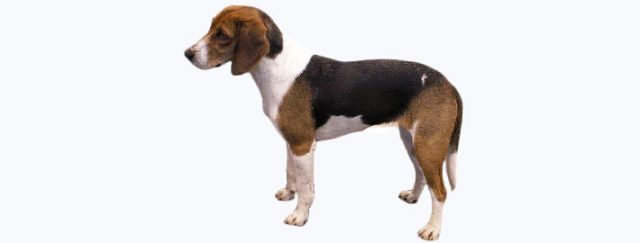Type the name of the breed you're looking for below
[wpdreams_ajaxsearchlite] Don't see the breed your're looking for? Click here and let us know!
Breed Characteristics
1 paw - breed exhibits the least amount of this characteristic
5 paws - breed exhibits most amount of this characteristic
Estonian Hound
| Country of Origin | Estonia |
| Weight | 33 - 44 lbs. (15 - 20 kg) |
| Height (at withers) | 17 - 21 in. (42 - 52 cm) |
| Coat | The coat is short, evenly rough and shiny. The undercoat is weakly developed. The tail is covered in its full length with even, thick hair and thus might seem a bit thick. Closer to the end of the tail the hair becomes shorter. |
| Colour | The Estonian Hound usually has black patches (limited with tan colours). The size of the patches is unlimited. Also allowed are a blackish brown colour, red patches and a saddle-like patch on the back. The tip of the tail has to be white. |
| Litter Size | 2 - 4 puppies |
| Life Span | 12 - 15 years |
| Origin & History | The Estonian Hound is relatively young breed that is already highly valued in Estonia, its country of origin. This breed resulted from the crossbreeding of several foreign dog breeds with local hunting dogs. The Estonian Hound’s development was announced by an ultimatum issued by the Soviet Union’s Ministry of Agriculture and Economy in 1947, which ordered every Soviet Republic to establish a local breed of hunting dogs to replace the large breeds of hunting dogs bred at that moment. These large dogs were blamed for the rapid decline of Estonia’s wildlife population; it was established that only dogs with a maximum height of 17 inches were allowed to hunt. The result was a very agile and hard driven breed that has enjoyed tremendous popularity since then: the modern Estonian Hound. After Estonia regained its independence, the Estonian Hound was proclaimed the country’s national dog. |
| Personality | The Estonian Hound is always happy and pleasant. It is balanced, calm and smart with an active temperament. It is friendly and should never be aggressive, but needs to be well socialized and exposed to new things to prevent it from being a bit timid of new situations. It is good with other dogs and usually good with cats if raised and socialized with them. It loves human attention, but make sure you are 100% pack leader to prevent it from getting upset when left alone. Proper human to canine communication is essential. Affectionate, it will love to snuggle up with its owners while watching TV. It has inherited from its predecessors such characteristics that make it very easy to teach it to not hunt hoofed animals as it is only allowed to hunt hare and fox in Estonia. The Estonian Hound has a beautiful voice when it hunts. A joy to hunters’ ears! |
Care Requirements
| Health | There are no known breed-specific health concerns. |
| Grooming | The short, rough coat is easy to groom. Bathe only when necessary. This breed is an average shedder. |
| Exercise | Estonian Hounds need lots of exercise (at least one 1.5-hour long walk a day), where the dog is made to heel beside or behind the human holding the lead, as instinct tells a dog the leader leads the way, and that leader needs to be the human. The Estonian Hound is an energetic working dog with enormous stamina. An Estonian Hound will love a long walk in the forest, if you have a safe area to do this, where it can run around. The Estonian Hound likes to follow its nose and is sometimes difficult to control when it picks up a scent and has taken up a lead. Take caution when exercising this breed around cars. Always use a lead in unsafe areas. |
| Other Considerations | The Estonian Hound is relatively inactive indoors if exercised sufficiently. It is best suited for a house with at least an average size yard. |



